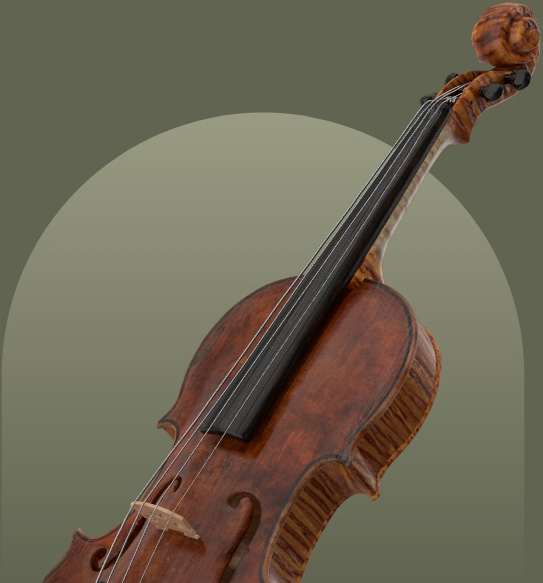John Dilworth
GILKES, Samuel Born 1787 Morton Pinkney, Northamptonshire, died 1827 London UK. Apprenticed to Charles Harris in London. Worked for William Forster (III) from 1810. Established own workshop at 4 Carteret Street, Westminster 1819. Had John Hart as apprentice from 1820, and also employed James Gibbs. Moved to 34 St James’s Street 1822. Made a range of instruments in various qualities, but the best are of the first rank. Amati model for violins particularly successful, but his best work is seen in his Stradivari cello copies. Yellow-brown or Forster-like dark red varnishes; poorest quality is a rather opaque and thin rubbed coat. Branded on linings and lower block; also externally on lower rib. Printed label: Gilkes (from Forster’s) / 34 James Street, Buckingham Gate, Westr. / London, 18.. Samuel Gilkes / fecit London. 1815 Samuel Gilkes / from Forster’s / Violin and Violoncello maker / 34 James Street. Buckingham Gate. Westminster
George Hart
Was born at Morton Pinkney, in Northamptonshire. He became an apprentice of Charles Harris, whose style he followed with much success. Upon leaving Harris he engaged himself to William Forster, making many instruments for him, retaining, however, all the features of the style of Harris. In the year 1810 he left the workshop of Forster, and commenced business on his own account in James Street, Buckingham Gate, where the few instruments bearing his name were made. Too much cannot be said in praise of this excellent maker; he was a thorough artist, and the exquisite finish of his works evidences that the making of them was to him a labour of love. Amati was his favourite model.
William Meredith Morris
He was born at Morton Pinkney, Northamptonshire, and died Nov. 1827. His work has been greatly praised by competent judges, and fully deserves to be. He died a comparatively young man, just as he was beginning to give the world the first-fruit of ripened talent. He started work on his own account in 1810, and for the next ten years he followed the lines of Charles Harris. The chief fault of his model of this period is that it is a copy of a copy. Many modern makers commit the same error, and we have to-day in the work of some amateurs copies that are removed from the original to the fifth or sixth degree. This is much to be deplored, as something is lost at each remove, and the result in the long run becomes a caricature. Originality pure and simple is quite a different thing, as in such a case the powers of the mind are unfettered and allowed free display. From 1820 on his work shows improvement in style, and his Amati and Stradivari copies of this period are excellent. He had probably had opportunity about the year 1820 of seeing and closely examining genuine Amati and Stradivari (grand) violins. The characteristics of his early Amati work are : a rather pronounced arching, narrow margins, a somewhat top-heavy scroll, and a very weak button ; and of the early Strad copies, rather gaping sound-holes, narrow margins, with a leaning towards the Amati arching, especially between the inner bouts, where there is also a decided groove between the sound-holes and the edge. These defects are nearly altogether eliminated in his latest and best work. The scroll of a Stradivari copy which I saw quite recently was thoroughly Italian in character, and the sound-holes beautifully cut and not too wide. The outline was pure and the arching very graceful. The wood of the back was cut on the quarter, with a curl of regular and medium width, and the pine was of close grain. The varnish was golden brown in colour, of a good quality and perfectly transparent. The tone was clear, bright, and mellow. It is a great pity Gilkes did not live another twenty years, because it is quite evident that he had just begun on a period of activity in production and accuracy of model. He was the pupil of his relative Charles Harris, and he worked for a few years with William Forster. Label : —
GILKES, FROM FORSTER’S, VIOLIN AMD VIOLONCELLO MAKER, 34 JAMES STREET, BUCKINGHAM GATE, WESTMINSTER
Cecie Stainer
b. 1787, Morton Pinkney, Northamptonshire; d. Nov., 1827, London. Apprenticed to Charles Harris, sen., in London, afterwards worked for William Forster ( 1764-1824). In 1810 he started his own business, labelling his instruments with his own name. He followed the Nicola Amati pattern, and was a clever maker, although his style showed traces of his training under Charles Harris. He used varnish of rich quality, and his work was beautifully finished. He made various classes of instruments for country dealers.
Willibald Leo Lütgendorff
Schüler von Charles Harris sen.; arbeitete bei William III. Forster und eröffnete
1810 seine eigene Werkstatt. Er arbeitete im Stile von Harris nach
dem Amati-Modell recht sauber und verwendete einen guten Lack. Er wurde
auch von Händlern viel beschäftigt. Seine Geigen und Violoncelli sind heute
sehr gesucht.
